Chooks
|
| Born around the beginning of April 2001, the
six chooks (3 bantams, 3 full sized) lived in their crêche for the first
six weeks, until they were almost totally filling it, necessitating quick
action from Patrick and I to build a real chicken boudoir - which took us
all weekend, but we were pleased at the end. |
 |
The chook crêche - a very large cardboard box with a
desk lamp suspended above it. I was concerned that the 3 “big”
chickies would peck at the 3 smaller ones, so put a cardboard divider down
the middle and poked the food tray through it. Later, when they got a
little bigger, they would roost on the top of the divider, so I gave up
and took it out. |
 |
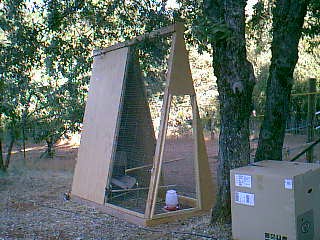 The
chicken boudoir stands 8' tall and has wheels on the back so we can
drag it around. It sits in a big heavy tray with no-climb mesh in the
bottom to prevent intruders digging their way in. We put it in the
orchard, which is fully fenced, next to where the horses are fed. The
chooks tend to put themselves to bed at dusk and I shut their door when I
feed the horses in the evening. In the morning I let them out to range
around on the property. They grub about in the dirt for hours and then
like to find cool spots under bushes and in the ivy to lie in during the
hot part of the day. They also regularly come up and wander around on the
deck. The
chicken boudoir stands 8' tall and has wheels on the back so we can
drag it around. It sits in a big heavy tray with no-climb mesh in the
bottom to prevent intruders digging their way in. We put it in the
orchard, which is fully fenced, next to where the horses are fed. The
chooks tend to put themselves to bed at dusk and I shut their door when I
feed the horses in the evening. In the morning I let them out to range
around on the property. They grub about in the dirt for hours and then
like to find cool spots under bushes and in the ivy to lie in during the
hot part of the day. They also regularly come up and wander around on the
deck. |
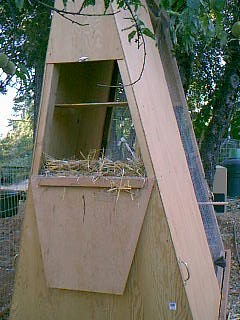 The
egg gathering door on the back of the boudoir. Since I took this pic,
I've put roosting rails in front of the nest boxes and for the most part,
they sleep on those. But there's usually one or two chickens who decide to
sleep in the nest boxes. So far, no eggs - they should be about old enough
to lay around September time when they're about six months old. The
egg gathering door on the back of the boudoir. Since I took this pic,
I've put roosting rails in front of the nest boxes and for the most part,
they sleep on those. But there's usually one or two chickens who decide to
sleep in the nest boxes. So far, no eggs - they should be about old enough
to lay around September time when they're about six months old.
|
 We
had one visit from a small grey fox in the orchard at dusk. Luckily it was
after the chooks had put themselves to bed, but in any case he seemed more
interested in eating the fallen apricots from the tree. We
had one visit from a small grey fox in the orchard at dusk. Luckily it was
after the chooks had put themselves to bed, but in any case he seemed more
interested in eating the fallen apricots from the tree. |
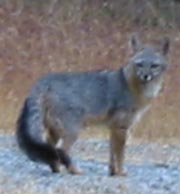 |
|
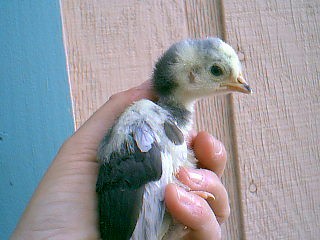 |
< Sardine as a young pup.
What he grew into >
(a White-Crested
Black Polish Bantam) |
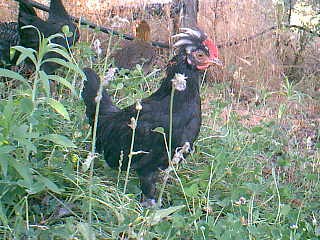 |
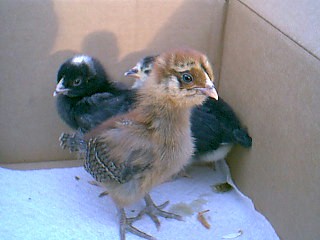 |
< Arabella Araucana as a sproglet... (with
Lamey (left) and Fig (right) hiding behind
her).
What she grew into >
(She's very handsome, but probably an Americana, seeing as she has
a tail, which Araucanas are not supposed to have. She does have
ear
tuffs, though) |
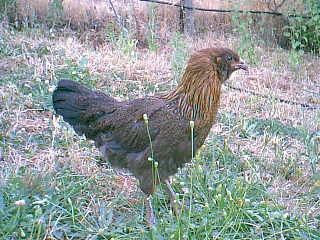 |
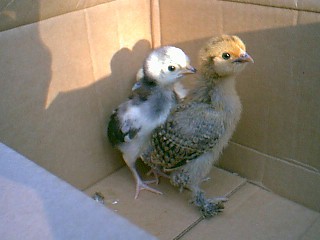 |
< Cabbage (with Sardine behind her, and Pies
cowering in the corner...)
What Cabbage turned into,> complete with snow-shoes
and ear-tufts. She's supposed to be a Golden Seabright Bantam...
well, nearly... right idea, wrong markings. |
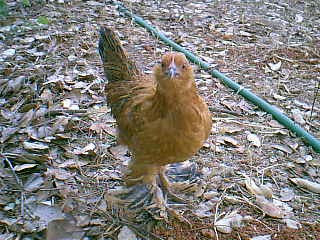 |
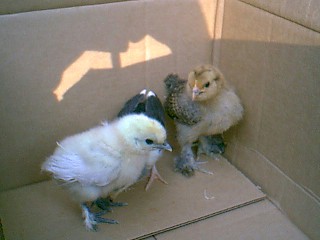 |
< Pies as a fluffy thing-ette...
(that's Cabbage to the right, and Sardine hiding behind)
Pies grown into a strapping > 8" high Silkie
Bantam, complete with tufty head
and blue cheeks |
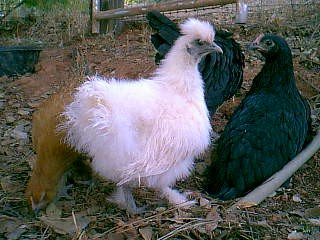 |
|
Below: Fig (right), with Arabella (brown)
& Lamey (behind) doing their cute look.
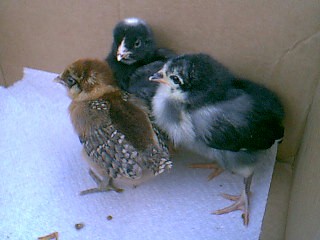
|
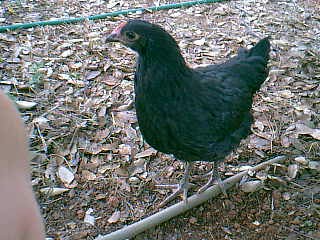 Fig
all growed-up. > Fig
all growed-up. >
She's a Black Australorp, is the biggest of the bunch, but sadly
isn't very photogenic. What you can't see here is the lovely green sheen
to her feathers. We're hoping her head will catch up with her body,
because she's a bit of a pin-head and always looks worried.
|
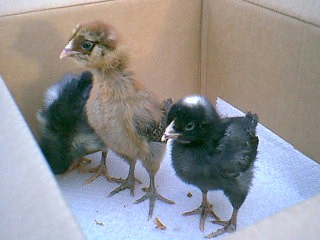 |
< Lamey (right) as a small, black chick with a white spot
on her head (Arabella appears to have spotted sommat over the
edge of the box).
Lamey is a Barred > Plymouth Rock and
named for my grandparents who live in Plymouth. She is the pecky one who
tried to take my eye out one morning and missed by half an inch. |
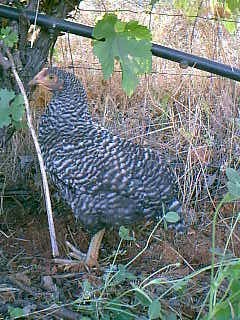 |
|
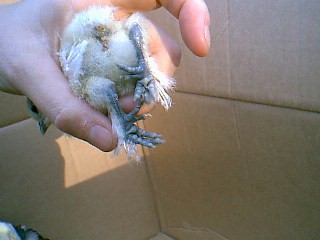 |
< Lil' Pies showing her extra toes - she has
five instead of the normal four, as well as funny leg feathers. Her name
means “feet” in Spanish.
Cabbage again, >
investigating a twitching stick in
the undergrowth. |
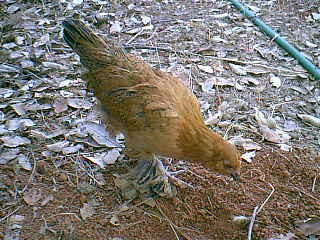 |
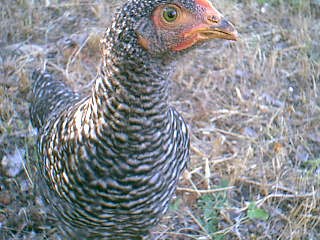 |
< Lamey eyeing my eye hopefully. Her pecking has
subsided, thankfully.
Lamey and Arabella > showing their
shapes
in the orchard. |
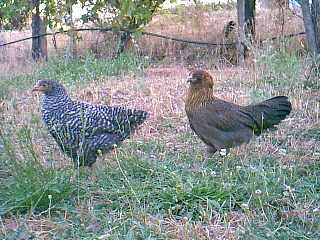 |
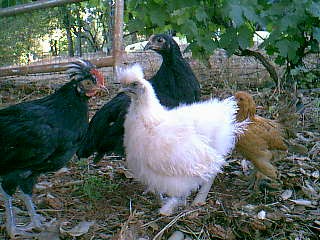 |
< Sardine, Pies, Fig, and Cabbage
wondering why I'm lying on the ground.
Lamey and Arabella
taking a quick nap.> |
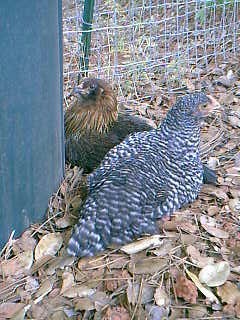 |
| Sardine, peck, peck, pecking... He just
started crowing the other day, at a little over 3 months old. So far, he
hasn't been too offensive, so he can stay (we made a rule when we first
got the chooks that any roosters that appeared would be sent back to the
shop. Luckily for Sardine, he's interesting enough to keep and isn't
mean.) |
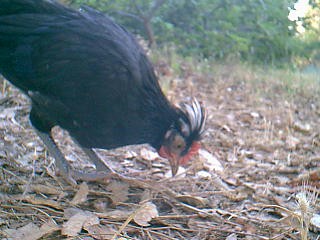 |
Right: See my hose tree. I have seven hoses
running from three taps, with two sets of timers. These feed the horse
water, the horse sprayer-schnozzle for horse baths, the drip feed system
in the orchard, a sprinkler in the terrace-paddock and a mister hose
running along the bank in front of the house. |
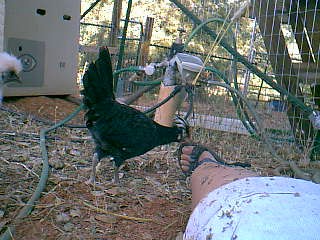 |
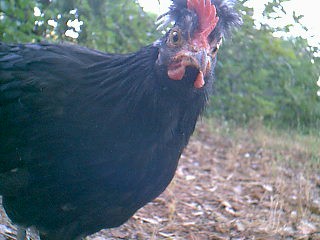 |
Sardine doing a “The Birds”
impersonation. |
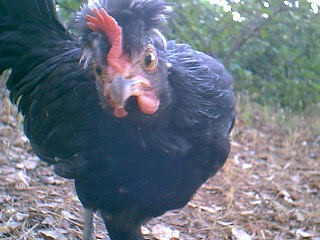 |
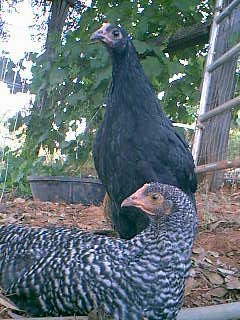 |
< Lamey and Fig. Behind them are the grape
vines on the orchard fence. To begin with, they just wanted to eat the
leaves... and then they discovered the grapes themselves - WOOOO. Now, no
grapes exist within chook reach any more. They will jump a couple of feet
to get at them.
Sardine and Pies. >
They didn't like me taking their photos - something to do with a predatory
staring camera lens? |
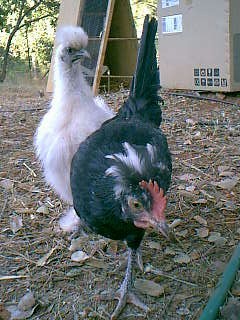 |
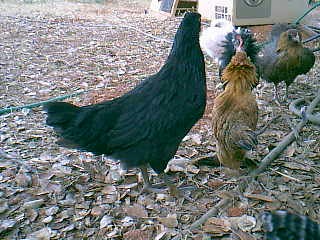 |
< Sardine and Cabbage facing each other
down, while Fig and Arabella spectate. I haven't figured out
what causes this, but they'll suddenly run up to each other, fluff out
their neck feathers and stand very tall for a few seconds.
Arabella and Sardine on the now disused
crêche. > |
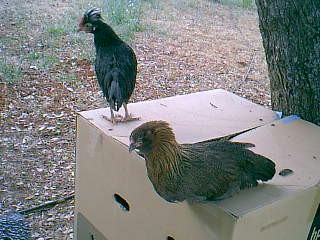 |
18 July 2001
elsie@foothill.net |


 The
chicken boudoir stands 8' tall and has wheels on the back so we can
drag it around. It sits in a big heavy tray with no-climb mesh in the
bottom to prevent intruders digging their way in. We put it in the
orchard, which is fully fenced, next to where the horses are fed. The
chooks tend to put themselves to bed at dusk and I shut their door when I
feed the horses in the evening. In the morning I let them out to range
around on the property. They grub about in the dirt for hours and then
like to find cool spots under bushes and in the ivy to lie in during the
hot part of the day. They also regularly come up and wander around on the
deck.
The
chicken boudoir stands 8' tall and has wheels on the back so we can
drag it around. It sits in a big heavy tray with no-climb mesh in the
bottom to prevent intruders digging their way in. We put it in the
orchard, which is fully fenced, next to where the horses are fed. The
chooks tend to put themselves to bed at dusk and I shut their door when I
feed the horses in the evening. In the morning I let them out to range
around on the property. They grub about in the dirt for hours and then
like to find cool spots under bushes and in the ivy to lie in during the
hot part of the day. They also regularly come up and wander around on the
deck. The
egg gathering door on the back of the boudoir. Since I took this pic,
I've put roosting rails in front of the nest boxes and for the most part,
they sleep on those. But there's usually one or two chickens who decide to
sleep in the nest boxes. So far, no eggs - they should be about old enough
to lay around September time when they're about six months old.
The
egg gathering door on the back of the boudoir. Since I took this pic,
I've put roosting rails in front of the nest boxes and for the most part,
they sleep on those. But there's usually one or two chickens who decide to
sleep in the nest boxes. So far, no eggs - they should be about old enough
to lay around September time when they're about six months old. We
had one visit from a small grey fox in the orchard at dusk. Luckily it was
after the chooks had put themselves to bed, but in any case he seemed more
interested in eating the fallen apricots from the tree.
We
had one visit from a small grey fox in the orchard at dusk. Luckily it was
after the chooks had put themselves to bed, but in any case he seemed more
interested in eating the fallen apricots from the tree. 









 Fig
all growed-up. >
Fig
all growed-up. > 














